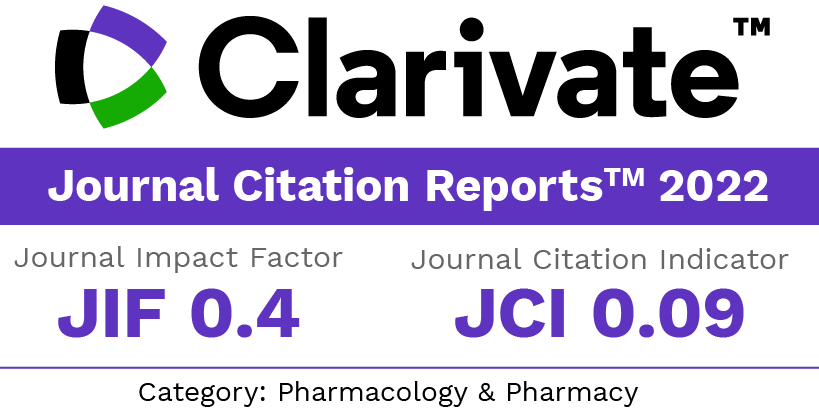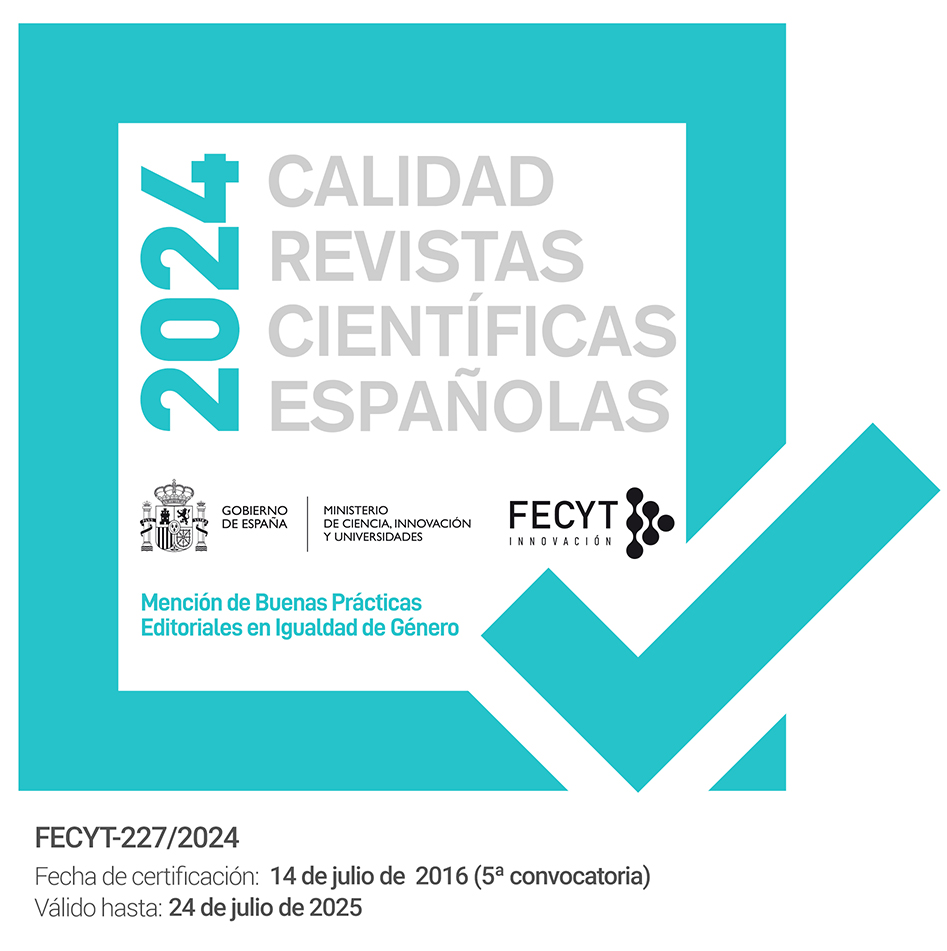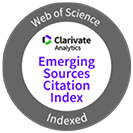Curcumin and its derivatives as potential antiviral candidates against monkeypox (mpox): a review of computational studies
DOI:
https://doi.org/10.30827/ars.v66i2.32423Keywords:
Antiviral, Curcumin, Monkeypox, Mpox, TurmericAbstract
Introduction: Monkeypox (mpox) is an infectious disease caused by the mpox virus that is of global health concern because the outbreak, as of May 2023, has affected more than 80,000 people in hundreds of countries. Currently, there is no specific treatment, including antivirals, for mpox patients. Exploration of active compounds for mpox continues, one of which is curcumin and its derivatives. Curcumin is a polyphenol compound predominantly found in turmeric which has been documented to have antiviral effects. Therefore, this study aims to explore studies investigating the potential of curcumin and its derivatives as antiviral candidates in targeting mpox.
Method: Literature published from inception to 2024 in ScienceDirect, PubMed, Scopus, and Google Scholar was searched. Keywords used in this search included curcuma, curcumin, tetrahydrocurcumin, demethoxycurcumin, bisdemethoxycurcumin, turmeric, monkeypox, and mpox.
Results: The literature search results found five computational studies involving the compound curcumin and its derivatives, including tetrahydroxycurcumin and demethoxycurcumin. All studies showed that curcumin and its derivatives have better binding affinity with mpox proteins compared to control of several antivirals. Curcumin and its derivatives have strong potential in inhibiting mpox virus replication and modulating the immune system.
Conclusions: This review concludes that curcumin and its derivatives have potential as antiviral candidates for mpox. However, related studies remain limited and confined to computational studies. Further preclinical experimental and clinical studies are needed to confirm their effectiveness and mechanisms of action.
Downloads
References
Kaler J, Hussain A, Flores G, Kheiri S, Desrosiers D. Monkeypox: A Comprehensive Review of Transmission, Pathogenesis, and Manifestation. Cureus. 2022;14(7):e26531. Doi: 10.7759/cureus.26531 DOI: https://doi.org/10.7759/cureus.26531
Anwar F, Haider F, Khan S, Ahmad I, Ahmed N, Imran M, et al. Clinical Manifestation, Transmission, Pathogenesis, and Diagnosis of Monkeypox Virus: A Comprehensive Review. Life. 2023;13(2):522. Doi: 10.3390/life13020522 DOI: https://doi.org/10.3390/life13020522
Thakur M, Das P, Sobti RC, Kaur T. Human monkeypox: epidemiology, transmission, pathogenesis, immunology, diagnosis and therapeutics. Mol Cell Biochem. 2023;478(9):2097–110. Doi: 10.1007/s11010-022-04657-0 DOI: https://doi.org/10.1007/s11010-022-04657-0
Zahmatyar M, Fazlollahi A, Motamedi A, Zolfi M, Seyedi F, Nejadghaderi SA, et al. Human monkeypox: history, presentations, transmission, epidemiology, diagnosis, treatment, and prevention. Front Med. 2023;10:1157670. Doi: 10.3389/fmed.2023.1157670 DOI: https://doi.org/10.3389/fmed.2023.1157670
Bragazzi NL, Kong JD, Mahroum N, Tsigalou C, Khamisy-Farah R, Converti M, et al. Epidemiological trends and clinical features of the ongoing monkeypox epidemic: A preliminary pooled data analysis and literature review. Journal of Medical Virology. 2023;95(1):e27931. doi: 10.1002/jmv.27931 DOI: https://doi.org/10.1002/jmv.27931
Mitjà O, Ogoina D, Titanji BK, Galvan C, Muyembe JJ, Marks M, et al. Monkeypox. The Lancet. 2023;401(10370):60–74. doi: 10.1016/S0140-6736(22)02075-X DOI: https://doi.org/10.1016/S0140-6736(22)02075-X
Ridho FM, Iqbal M, Laksono EP, Leal RSS. Oral and Perioral Manifestations in Monkeypox Patients: A Systematic Review of Case Reports and Case Series. Jurnal Kedokteran Diponegoro (Diponegoro Medical Journal). 2024;13(5):240–53. Doi: 10.14710/dmj.v13i5.42539 DOI: https://doi.org/10.14710/dmj.v13i5.42539
Sari M, Hairunisa N. A Review of the Monkeypox Outbreak in Indonesia in 2022. Jurnal Kedokteran Diponegoro (Diponegoro Medical Journal). 2022;11(5):268–74. Doi: 10.14710/dmj.v11i5.35895 DOI: https://doi.org/10.14710/dmj.v11i5.35895
Khan G, Perveen N. The 2022 monkeypox outbreak 1 year on: The 5 Ws. Reviews in Medical Virology. 2024;34(1):e2489. Doi: 10.1002/rmv.2489 DOI: https://doi.org/10.1002/rmv.2489
Shomuyiwa DO, Manirambona E. Monkeypox virus declared as a global health emergency: What next for Africa’s preparedness? Travel Medicine and Infectious Disease. 2023;53:102577. Doi: 10.1016/j.tmaid.2023.102577 DOI: https://doi.org/10.1016/j.tmaid.2023.102577
Rizk JG, Lippi G, Henry BM, Forthal DN, Rizk Y. Prevention and Treatment of Monkeypox. Drugs. 2022;82(9):957–63. Doi: 10.1007/s40265-022-01742-y DOI: https://doi.org/10.1007/s40265-022-01742-y
Cheema AY, Ogedegbe OJ, Munir M, Alugba G, Ojo TK. Monkeypox: A Review of Clinical Features, Diagnosis, and Treatment. Cureus. 2022;14(7):e26756. Doi: 10.7759/cureus.26756 DOI: https://doi.org/10.7759/cureus.26756
Sudarmaji N, Kifli N, Hermansyah A, Yeoh SF, Goh BH, Ming LC. Prevention and Treatment of Monkeypox: A Systematic Review of Preclinical Studies. Viruses. 2022;14(11):2496. Doi: 10.3390/v14112496 DOI: https://doi.org/10.3390/v14112496
Shamim MA, Padhi BK, Satapathy P, Veeramachaneni SD, Chatterjee C, Tripathy S, et al. The use of antivirals in the treatment of human monkeypox outbreaks: a systematic review. International Journal of Infectious Diseases. 2023;127:150–61. Doi: 10.1016/j.ijid.2022.11.040 DOI: https://doi.org/10.1016/j.ijid.2022.11.040
Singhal T, Kabra SK, Lodha R. Monkeypox: A Review. Indian J Pediatr. 2022;89(10):955–60. Doi: 10.1007/s12098-022-04348-0 DOI: https://doi.org/10.1007/s12098-022-04348-0
Shaker B, Ahmad S, Lee J, Jung C, Na D. In silico methods and tools for drug discovery. Computers in Biology and Medicine. 2021;137:104851. Doi: 10.1016/j.compbiomed.2021.104851 DOI: https://doi.org/10.1016/j.compbiomed.2021.104851
Patel SS, Acharya A, Ray RS, Agrawal R, Raghuwanshi R, Jain P. Cellular and molecular mechanisms of curcumin in prevention and treatment of disease. Critical Reviews in Food Science and Nutrition. 2020;60(6):887–939. Doi: 10.1080/10408398.2018.1552244 DOI: https://doi.org/10.1080/10408398.2018.1552244
Peng Y, Ao M, Dong B, Jiang Y, Yu L, Chen Z, et al. Anti-Inflammatory Effects of Curcumin in the Inflammatory Diseases: Status, Limitations and Countermeasures. DDDT. 2021;15:4503–25. Doi: 10.2147/DDDT.S327378 DOI: https://doi.org/10.2147/DDDT.S327378
Rahmani A, Alsahli M, Aly S, Khan M, Aldebasi Y. Role of Curcumin in Disease Prevention and Treatment. Adv Biomed Res. 2018;7(1):38. Doi: 10.4103/abr.abr_147_16 DOI: https://doi.org/10.4103/abr.abr_147_16
Ridho FM, Syachputra AJ, Fahrudin P, Nurhuda A, Nurliana N, Latuamury NS. In vitro and in vivo effects of curcumin on oral cancer: a systematic review. Current Biomedicine. 2024;2(2):101–15. Doi: 10.29244/currbiomed.2.2.101-115 DOI: https://doi.org/10.29244/currbiomed.2.2.101-115
Ridho FM, Syachputra AJ, Nur’aini AD, Ulfah K, Faqih M, Nurhuda A. Pre-clinical and clinical efficacy of curcumin as an anti-inflammatory agent for periodontitis. A systematic review. Revista Científica Odontológica. 2024;12(4):e222. Doi: 10.21142/2523-2754-1204-2024-222 DOI: https://doi.org/10.21142/2523-2754-1204-2024-222
Ardebili A, Pouriayevali MH, Aleshikh S, Zahani M, Ajorloo M, Izanloo A, et al. Antiviral Therapeutic Potential of Curcumin: An Update. Molecules. 2021;26(22):6994. Doi: 10.3390/molecules26226994 DOI: https://doi.org/10.3390/molecules26226994
Jennings MR, Parks RJ. Curcumin as an Antiviral Agent. Viruses. 2020;12(11):1242. Doi: 10.3390/v12111242 DOI: https://doi.org/10.3390/v12111242
Sharma A, Sharma T, Bhaskar R, Ola M, Sharma A, Sharma PC. Promising Potential of Curcumin and Related Compounds for AntiviralDrug Discovery. MC. 2024;20(6):597–612. Doi: 10.2174/0115734064277371240325105016 DOI: https://doi.org/10.2174/0115734064277371240325105016
Srivastava BBL, Ripanda AS, Mwanga HM. Ethnomedicinal, Phytochemistry and Antiviral Potential of Turmeric (Curcuma longa). Compounds. 2022;2(3):200–21. Doi: 10.3390/compounds2030017 DOI: https://doi.org/10.3390/compounds2030017
Mathew D, Hsu WL. Antiviral potential of curcumin. Journal of Functional Foods. 2018;40:692–9. Doi: 10.1016/j.jff.2017.12.017 DOI: https://doi.org/10.1016/j.jff.2017.12.017
Akash S, Hossain A, Hossain MdS, Rahman MdM, Ahmed MZ, Ali N, et al. Anti-viral drug discovery against monkeypox and smallpox infection by natural curcumin derivatives: A Computational drug design approach. Front Cell Infect Microbiol. 2023;13:1157627. Doi: 10.3389/fcimb.2023.1157627 DOI: https://doi.org/10.3389/fcimb.2023.1157627
Alagarsamy V, Shyam Sundar P, Raja Solomon V, Narendhar B, Sulthana MT, Rohitha K, et al. Pharmacophore modelling-based drug repurposing approaches for monkeypox therapeutics. Journal of Biomolecular Structure and Dynamics. 2023;41(20):10678–89. Doi: 10.1080/07391102.2023.2188428 DOI: https://doi.org/10.1080/07391102.2023.2188428
Banik A, Ahmed SR, Shahid SB, Ahmed T, Tamanna HK, Marma H. Therapeutic Promises of Plant Metabolites against Monkeypox Virus: An In Silico Study. Lin SC, editor. Advances in Virology. 2023;2023:1–16. Doi: 10.1155/2023/9919776 DOI: https://doi.org/10.1155/2023/9919776
Maurya VK, Kumar S, Maurya S, Ansari S, Paweska JT, Abdel-Moneim AS, et al. Structure-based drug designing for potential antiviral activity of selected natural product against Monkeypox (Mpox) virus and its host targets. VirusDis. 2024;35(4):589–608. Doi: 10.1007/s13337-024-00900-y DOI: https://doi.org/10.1007/s13337-024-00900-y
Rout M, Mishra S, Dey S, Singh MK, Dehury B, Pati S. Exploiting the potential of natural polyphenols as antivirals against monkeypox envelope protein F13 using machine learning and all-atoms MD simulations. Computers in Biology and Medicine. 2023;162:107116. Doi: 10.1016/j.compbiomed.2023.107116 DOI: https://doi.org/10.1016/j.compbiomed.2023.107116
Kumer A, Chakma U, Rana MM, Chandro A, Akash S, Elseehy MM, et al. Investigation of the New Inhibitors by Sulfadiazine and Modified Derivatives of α-D-glucopyranoside for White Spot Syndrome Virus Disease of Shrimp by In Silico: Quantum Calculations, Molecular Docking, ADMET and Molecular Dynamics Study. Molecules. 2022;27(12):3694. Doi: 10.3390/molecules27123694 DOI: https://doi.org/10.3390/molecules27123694
Xu Y, Wu Y, Wu X, Zhang Y, Yang Y, Li D, et al. Structural basis of human mpox viral DNA replication inhibition by brincidofovir and cidofovir. International Journal of Biological Macromolecules. 2024;270:132231. Doi: 10.1016/j.ijbiomac.2024.132231 DOI: https://doi.org/10.1016/j.ijbiomac.2024.132231
Hussain Y, Alam W, Ullah H, Dacrema M, Daglia M, Khan H, et al. Antimicrobial Potential of Curcumin: Therapeutic Potential and Challenges to Clinical Applications. Antibiotics. 2022;11(3):322. Doi: 10.3390/antibiotics11030322 DOI: https://doi.org/10.3390/antibiotics11030322
Lu J, Xing H, Wang C, Tang M, Wu C, Ye F, et al. Mpox (formerly monkeypox): pathogenesis, prevention and treatment. Sig Transduct Target Ther. 2023;8(1):458. Doi: 10.1038/s41392-023-01675-2 DOI: https://doi.org/10.1038/s41392-023-01675-2
Parnian R, Heydarifard F, Mousavi FS, Heydarifard Z, Zandi M. Innate Immune Response to MPOX Infection: Mechanisms and Immune Escape. J Innate Immun. 2024;16(1):413–24. Doi: 10.1159/000540815 DOI: https://doi.org/10.1159/000540815
Downloads
Published
How to Cite
Issue
Section
License
Copyright (c) 2025 Fiki Muhammad Ridho, Anisa Dias Nur'aini, Hamnah Al Atsariyah, Andika Julyanto Syachputra, Wisnu Eka Wardana, Andang Nurhuda

This work is licensed under a Creative Commons Attribution-NonCommercial-ShareAlike 4.0 International License.
The articles, which are published in this journal, are subject to the following terms in relation to the rights of patrimonial or exploitation:
- The authors will keep their copyright and guarantee to the journal the right of first publication of their work, which will be distributed with a Creative Commons BY-NC-SA 4.0 license that allows third parties to reuse the work whenever its author, quote the original source and do not make commercial use of it.
b. The authors may adopt other non-exclusive licensing agreements for the distribution of the published version of the work (e.g., deposit it in an institutional telematic file or publish it in a monographic volume) provided that the original source of its publication is indicated.
c. Authors are allowed and advised to disseminate their work through the Internet (e.g. in institutional repositories or on their website) before and during the submission process, which can produce interesting exchanges and increase citations of the published work. (See The effect of open access).























